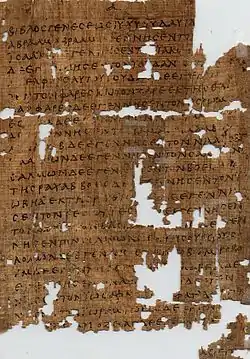Papyrus 1
Papyrus 1 (in der Nummerierung nach Gregory-Aland 1) ist eine frühe Kopie des Neuen Testaments in griechisch. Es ist ein Papyrusmanuskript des Matthäusevangeliums und wird auf das 3. Jahrhundert datiert.
| Papyrus 1 | |
|---|---|
 | |
| Name | P. Oxy. I 2 |
| Text | Matthäus 1:1–9,12,14–20 |
| Datum | ca. 250 |
| Gefunden | Oxyrhynchus, Ägypten |
| Lagerort | University of Pennsylvania Museum of Archaeology and Anthropology (Penn Museum) |
| Quelle | B. P. Grenfell und A. S. Hunt, Oxyrhynchus Papyri I, S. 4–7, 1898. |
| Größe | 1 Blatt; 12 cm × 25 cm; 37–38 Zeilen pro Seite |
| Typ | Alexandrinischer Texttyp |
| Kategorie | I |
| Notiz | Im Text nahe bei Cod. Vaticanus |
Zurzeit wird es im Museum der Universität von Pennsylvania unter der Signatur E 2746 aufbewahrt. Es wurde in Oxyrhynchus in Ägypten entdeckt. Das Manuskript ist ein Fragment aus einem Blatt, so gefaltet, dass sich zwei Seiten ergeben mit je einer Spalte pro Seite. Auf jeder Seite finden sich 27–29 Zeilen, die Maße betragen etwa 14,7 cm × 15 cm. Noch erhalten geblieben ist der Text aus Matthäus 1,1–9.12 und 13, 14–20. Mittels Paläographie wurde es auf das frühe 3. Jahrhundert datiert.[1]
Text
Der Text des Kodex enthält Nomina sacra und lässt sich dem alexandrinischem Texttyp zuordnen. Aland ordnete es in die Kategorie I ein.[1]
1 folgt dem Text des Codex Vaticanus.[2] Die meisten Abweichungen finden sich in der Aussprache der Namen in der Abstammungslinie Jesu.
Recto
- [1,1] βιβλος γενεσεως ι̅υ̅ χ̅υ̅ υ̅υ̅ δαυιδ [υ̅υ̅]
- αβρααμ [1,2] αβρααμ ε̣γ̣εννησεν τον̣ [ισαακ]
- ισαακ δ̣[ε] ε̣γενν̣η̣σεν τ[ον] ιακω̣β̣ [ιακωβ]
- δε εγ[ε]ν̣ν̣ησεν̣ τ̣ον̣ ιου̣δαν κ̣[α]ι̣ τ̣[ους]
- α̣[δ]ελφο̣υ̣ς αυτου [1,3] ιουδα̣ς̣ δ̣ε εγεν̣ν̣η̣
- σ̣ε̣ν̣ τον φαρες και τον ζαρε εκ της θα̣
- μ̣αρ̣ φαρες δε εγεννησεν τον ε̣σρ̣ωμ
- εσ[ρω]μ̣ δε εγ̣ε̣ννη̣σ̣ε̣ν τ̣[ο]ν̣ α̣ρ̣α̣μ̣ [1,4] α̣[ραμ]
- δε̣ [ε]γ̣ε̣ννησεν το̣ν̣ α̣μ̣μ̣ι̣ν̣α̣δ̣α̣β̣ α̣μ̣
- μ̣[ι]ν̣α̣δ̣[α]β δε εγεννησεν̣ τον ναασ̣σων
- ν̣αα[σ]σων δε εγενν[ησ]ε̣ν τον σαλ̣[μω]ν
- [1,5] σαλμων δε εγενν[η]σ̣εν τον βοες̣ [εκ]
- της ραχαβ βοες δε ε̣γ̣ε̣ννησεν τον ι
- ωβηδ εκ της ρ[ο]υθ ιω̣[βηδ δ]ε εγεννη̣
- σεν τον ιεσ̣σ̣α̣ι [1,6] ιεσ̣σ̣[αι] δ̣ε ε̣γ̣ε̣ν̣νησεν
- τον δα̣υ̣ι̣δ̣ τ̣ον βα̣σιλ̣ε̣[α δαυ]ι̣δ̣ δ̣ε̣ εγ̣εν
- νησ̣εν τον σο̣λο̣μωνα̣ ε̣κ̣ τ̣η̣ς ουρειου. [1,7] σο̣
- λομ̣ων δε εγενν̣ησ̣εν̣ τ̣ο̣ν̣ [ρ]οβοαμ ροβο
- α̣μ δε εγ̣ενν̣η̣σ̣εν̣ τ̣[ο]ν̣ [αβει]α αβ̣ει̣α̣ δε
- εγεν̣ν̣ησεν [το]ν ασα̣[φ] [1,8] [α]σ[α]φ̣ δε̣ ε̣γ̣ε̣ν
- νη̣σ̣ε̣ν̣ τον ιωσαφατ̣ ι̣[ω]σ̣α̣φατ δ[ε] ε̣γε̣ν
- ν[η]σ̣ε̣[ν] το̣ν̣ ιωραμ ιωρ̣α̣μ̣ δε εγεν̣[νησεν
- τον] ο̣ζε̣[ι]α̣ν [1,9] οζει̣ας̣ δ̣ε εγ̣εν̣[νησεν]
- lacuna [1,12] lacuna [με
- τοικεσιαν βαβυλωνος ιεχονι]ας εγ[εν
- νησεν] lacuna
Verso
- [1,14] lacuna
- [τον σ]α̣δω[κ σ]αδωκ̣ δε̣ ε̣γεννησεν το[ν
- αχειμ] αχ̣ειμ δε εγε[ν]νησεν τον ελιου[δ]
- [1,15] [ελιου]δ̣ δ̣ε̣ εγ[εν]νη̣[σ]ε̣[ν] τον ελε̣α̣ζαρ ελε
- [αζ]α̣ρ [δε εγ]ενν̣ησεν [το]ν μ̣α̣θ̣θα̣ν̣ μαθθα̣[ν]
- δ̣ε ε̣γε̣ν̣νη̣[σ]ε̣ν τον̣ [ι]ακωβ [1,16] ια̣κωβ δε
- [εγ]εννησ̣εν̣ τ̣ον ιωσ̣η̣φ τον α̣νδρα μ̣[α]
- ρ̣ι̣ας̣ [ε]ξ ης εγενν[ηθ]η̣ ι̅ς̅ ο λεγομενο[ς χ̅̅ς̅]
- [1,17] π̣ασ̣α̣ι̣ ο̣υ̣ν̣ γ̣ε̣[νε]α̣ι̣ α̣πο αβρααμ εω̣ς̣
- δαυιδ γενεαι ι̅δ̣̅ και̣ απο̣ [δ]α̣[υ]ι̣δ̣ [ε]ω̣ς̣ τ̣η̣[ς]
- μετοικεσ̣ια̣ς βαβυλωνο̣[ς] γ̣ε[νεαι] ι̅δ̣̅ κ̣α̣[ι]
- α̣π̣ο της μετ̣[οι]κεσι̣ας βα̣β[υ]λων̣[ο]ς εως
- του χ̅υ̣̅ γ̣ενε̣α̣ι̣ [ι̅]δ̅ [1,18] του δε ι̅υ̣̅ χ̅υ̅ η γενε
- σις ουτως ην μ̣ν̣ηστ̣ε̣[υ]θεισης της μη
- τρος αυτου μ̣[αρι]α̣[ς] τω̣ [ιω]σηφ πριν η συν
- [ε]λ̣θε̣[ι]ν αυ[το]υ̣[ς] ε̣υ̣ρε̣[θη] ε̣ν γ̣αστρι εχου
- σα̣ ε̣[κ π̅ν̅ς̅ αγιου] [1,19] [ιωσηφ δε ο] ανη̣ρ̣ α̣υ̣
- τ̣η̣ς̣ [δι]κ̣α̣ι[ος ων και μη θελων αυτην]
- δ̣ειγμα̣[τ]ε̣[ισαι εβουλη]θ̣η̣ [λαθρα
- α]π̣ο̣λυ[σαι] α̣[υ]τ̣[η]ν̣ [1,20] [τ]αυ̣τ̣α̣ [δε αυτου εν
- θ]υ̣μ̣η[θεντος ι]δ̣ο̣υ̣ α̣γ̣[γελο]ς̣ κ̣̅υ̣̅ [κ]α̣[τ
- ο]ν̣αρ [εφανη αυ]τω̣ [λεγων] ι̣ω̣σ̣[η]φ
- υιος] δ̣[αυιδ] μ̣[η] φο̣[βηθη]ς̣ π̣α̣ρ̣[αλαβ]ει̅
- [μ]α̣ρι̣α̣ν̣ [την] γ̣υ̣ναι[κα σου] τ̣ο̣ [γαρ εν αυ
- τη γεν]νηθ̣ε̣ν̣ ε̣[κ] π̅ν̅ς̅ [εστιν] α̣[γιου]
- [1,21-23] lacuna
- με̣[θερμηνευομενον μεθ ημων ο θ̅ς̅]
Geschichte
Bernard Pyne Grenfell und Arthur Surridge Hunt entdeckten den Papyrus in Oxyrhynchus in Ägypten am zweiten Tag der Ausgrabungen im Winter 1896–1897. Ihre Funde wurden im ersten Band der The Oxyrhynchus Papyri im Jahre 1898 veröffentlicht.
Literatur
- Kurt Aland: Kurzgefaßte Liste der griechischen Handschriften des Neuen Testaments – in Verbindung mit Michael Welte bearb. von Kurt Aland. de Gruyter, Berlin/New York 1994, 2. neubearbeitete und ergänzte Auflage, ISBN 3-11-011986-2, (Arbeiten zur neutestamentlichen Textforschung Bd. 1).
- B. P. Grenfell & A. S. Hunt, Oxyrhynchus Papyri I (London, 1898), S. 4–7.
- Caspar René Gregory, Die griechischen Handschriften des Neuen Testament, S. 44.
- Wessely, Les plus anciens monuments du christianisme, Patrologia Orientalis IV, 2, 1907, S. 142–144.
- Schofield, The Papyrus Fragments of the Greek New Testament, Diss. Louisville 1936, S. 86–91.
- Philip W. Comfort and David P Barrett. The Text of the Earliest New Testament Greek Manuscripts. Wheaton, Illinois: Tyndale House Publishers Incorporated, 2001, S. 40–41. (full text of the codex transcribed)
Einzelnachweise
- Kurt und Barbara Aland: Der Text des Neuen Testaments. Einführung in die wissenschaftlichen Ausgaben sowie in Theorie und Praxis der modernen Textkritik. Deutsche Bibelgesellschaft, Stuttgart 1989, ISBN 3-438-06011-6, S. 106.
- Philip W Comfort und David P Barrett, The Text of the Earliest New Testament Greek Manuscripts, Wheaton, Illinois: Tyndale House Publishers Incorporated, 2001, p. 39.
Weblinks
Facsimilien von P1 (große Dateien, Bilder mit hoher Auflösung):